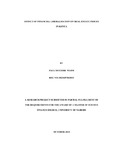| dc.description.abstract | The study sought to establish the effect or financial liberalization on real estate prices
in Kenya. Specifically, the study sought to establish the effect of Central Bank Rate
(CBR), Commercial Bank Lending Rate, and Inflation Rates on Real Estate Prices in
Kenya. The study followed a descriptive research design and used secondary data.
The study used average annual secondary data for the periodbetween 2000 – 2013.
The independent variables CBR, Interest Rate, and Inflation were obtained from
CBK website, while the Real Estate Prices were obtained from Hass Consult. The
study used excels spread sheets to organize the data and SPSS version 20 to analyse
the data. The study established that the study variables fluctuated throughout the
period. Also, the study established that Real Estate Prices grew each year since 2000
to 2013 with growth spurts during the 2001/2002 (19.91%) and 2008/2009 (20.90%).
Regression analysis results revealed that there is a strong positive relationship
between the independent variables (CBR, Commercial Bank Lending Rates, and
Inflation Rate) with Coefficient of determination (R=0.816), but the independent
variables would explain 56.6% of the change in Real estate prices (R Square
=0.566); hence 43.4% of change in real estate prices is caused by other factors.
Further, with a p-value equal to 0.009 the results implied that the regression model
was significant in predicting the relationship between Real Estate Prices and the
predictor variables as it was less than α=0.05. However, F-table tabulated at F14; 3;
0.05 was 8.74 which was greater that F= 6.661 determined through analysis
depicting that the model was insignificant.The study concludes that a change in CBR
causes the highest influence on real estate prices followed by the inflation rates since
the coefficient corresponding to Central bank rate (CBR) was statistically significant
(p-value was 0.001), while Commercial Bank Lending Rate and Inflation Rate were
statistically insignificant as depicted by P-Values equal to 0.756 and 0.448
respectively. The study recommends that policy makers and regulators should enact
and uphold rules that ensure that real estate prices remain affordable for the
citizenry. Also, CBR should be regulated very cautiously because its corresponding
correspondent was statistically significant while those corresponding to lending rates
and inflation rates were statistically insignificant. Also, the study recommends that
future studies should be conducted to find out the relevant regulatory and policy
issues that should be developed and employed by regulatory policy makers in order
to appropriately guide financial liberalization in the country. Moreover, future
studies could include more variables that affect the real estate prices. Also, future
studies may consider cross-economy comparisons. | en_US |

